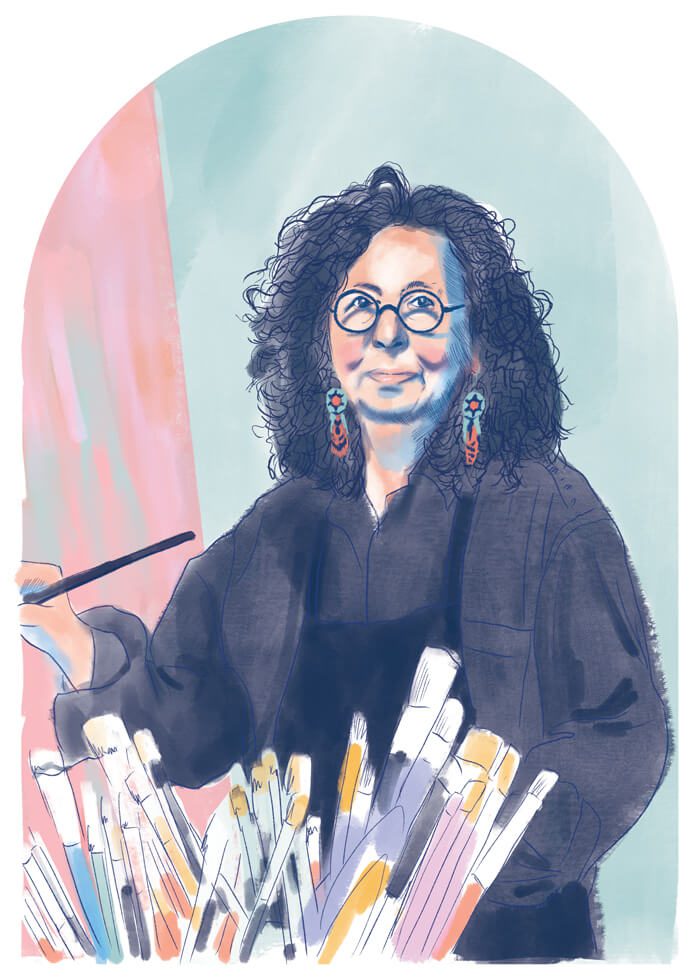
Name: Jaune Quick-to-See Smith
Born: January 15, 1940, St. Ignatius Mission, Flathead Indian Reservation, Montana
Lives: Corrales, New Mexico
Role: Cultural arts worker, activist, curator
Quote: “I always tell my students, ‘Art can keep your life balanced and healthy. Art is my obsession.’”
When I asked Jaune Quick-to-See Smith (Salish member of the Confederated Salish and Kootenai Nation, Montana) how she came to call herself a cultural arts worker, her reply began with a short history of her tribe’s trading practices. “I come from a long line of Indian traders, not merchants who house goods but traders who pass resources from one place to another.” She told me about her family, including her great grandmother, Marie Rose Delorme Smith, who “ran trap lines, became a medicine woman and midwife, raised seventeen children, established a boarding house, wrote about her life for the Canadian Cattlemen newspaper, and helped establish the Métis Registry of Alberta, Canada.” Quick-to-See Smith illustrated a book about her other relatives, a Salish great aunt and her sister Quick-to-See, which “takes place during the fur trade, when Indian women were often bought for domestic slaves and had to be entrepreneurial, creative—and mostly raised children alone.” From her reply, it becomes clear that Quick-to-See Smith’s work is deeply embedded in her family and her tribe’s past.
This is my lineage, my heritage, these are my antecedents, that have impacted my world view and that cause me to do the work that I’ve done most of my adult life. It’s about networking, trading intellectual ideas, bringing people together, being a catalyst to make things happen, and above all being an activist, acting on those things that I see need to be done and that can make something more positive or helpful to others. This is what it’s all about. And in the end, this comes back to feed my art.
Quick-to-See Smith’s art traffics in images and language drawn from her Native heritage, U.S. consumer culture, history, and landscape. Her paintings incorporate meaning through collaged elements, color, and energetic gesture. And her life has been just as rich and engaged with the world around her as her artwork. She came to New Mexico to study in the largest Native American Studies program, hoping to teach at the Institute of American Indian Arts (IAIA) after graduating. Instead, she ended up on the IAIA Board of Trustees, went to Washington, D.C., and Linda Lomahaftewa and Karita Coffey helped her in a letter writing campaign to pass legislation to “make the school freestanding and a line item to Congress like Gallaudet and Howard University.”
After teaching at Albuquerque Indian School for a year, Quick-to-See Smith organized the Grey Canyon Artists named by Larry Emerson (Diné). Her work was exhibited by a number of galleries in New Mexico, including LewAllen Gallery where she stayed for thirty years. Now her art is housed by MoMA, the Whitney, the Met, the Smithsonian, and many other institutions.
Her impact as a curator is equally deep. She began searching for Native photographers in the late 1970s, a time when “we never saw any photographs made by Native peoples. It took about four years to locate fifteen Native Americans who made mostly small Brownie black-and-white photographs. Then I couldn’t get any gallery or museum interested, because they weren’t close-up portraits, like the photos of Edward Curtis.” The show—the first touring exhibition of Native photography—was finally picked up by Rosemary Ellison for an exhibition at the Southern Plains Museum and traveled to many other places in the U.S. and in Europe. Her exhibition of living Native women artists, also the first of its kind, was called Women of Sweetgrass, Cedar, and Sage and was co-curated by Harmony Hammond, with a catalogue essay by Lucy Lippard. Quick-to-See Smith is also responsible for the contemporary Native art collection at the Missoula Art Museum, to which she donated money, art by other Native people, and her life’s work in prints.
These days, Quick-to-See Smith is working on a book on contemporary Native art with Mario Caro and her son, Neal Ambrose-Smith, painter, printmaker, and chair of the art department at IAIA. She has plans to start a scholarship, to organize another Native women’s exhibition, to create an image bank of contemporary Native Artists at UNM, and she was asked to do a solo exhibition in March 2020 at Garth Greenan Gallery in New York. It’s clear that her practice as a cultural arts worker is not about the individualistic pursuit of career and status, though she has achieved both. Instead, her focus is always on a larger community. “The Crees have a word, wahkootowin, for this,” she tells me, “meaning everything we do is for community, that we always take into account [that] our actions affect our family, our tribe, and our relations, friends, and acquaintances. You might say our community of humans.”



